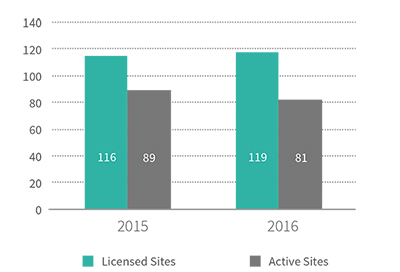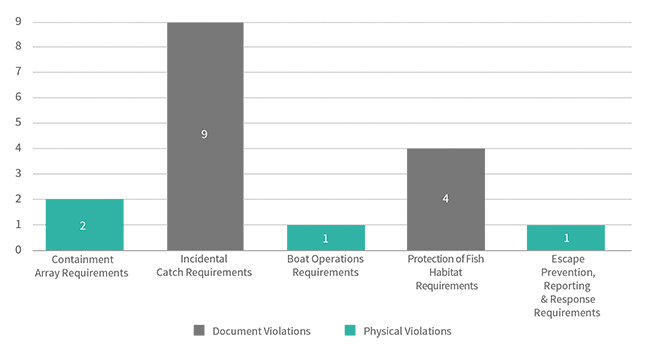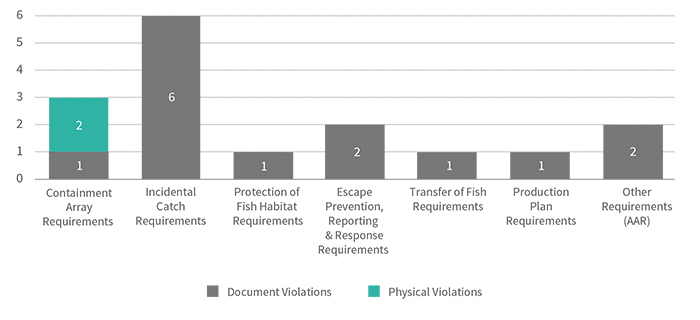Regulating and monitoring British Columbia’s marine finfish aquaculture facilities 2015–2016: Assessing compliance
Table of Contents
- Summary of marine finfish aquaculture in British Columbia
- How aquaculture facilities are regulated
- Assessing compliance
- Reporting requirements and reports submitted
- Monitoring and audits: Fish health
- Monitoring and audits: Environmental
- Monitoring and audits: Inventory and aquaculture statistics
- Summary
How DFO assesses the performance of aquaculture facilities
DFO conducts audits, monitoring and surveillance activities to establish a clear picture of the BC fish farming companies’ (“aquaculture industry’s”) operational and environmental performance. Information gained through these activities allows the Department to assess its current regulatory approach and inform future management decisions. DFO analyzes the results of site inspections and technical audits and reports the results online to give the public a view of the industry performance. Figure 2 shows the number of facilities that were licensed in 2015 and 2016 and the number that were stocked with fish, or “active”, for at least one day in a calendar year. It is important to note that not all facilities are stocked with fish at the same time due to the normal cycle of finfish farming.

Figure 2. Marine Finfish Aquaculture Facilities - Table version
| 2015 | 2016 | |
|---|---|---|
| Licensed sites | 116 | 119 |
| Active sites | 89 | 81 |
In 2015 and 2016, site visits were conducted year round by Fishery Officers and other DFO staff including veterinarians, biologists, and fish health technicians.
Monitoring and surveillance activities included:
- Assessing compliance with licence conditions
- complete and accurate records and paperwork
- no culturing of unlicensed species
- production at or below the licensed maximum
- appropriate markings and signage
- appropriate storage and tagging of equipment, feed, and chemicals
- compliance with Fish Health Management Plans
- site debris being managed appropriately
- complete and accurate containment array plans, marine mammal management plans, and fish escape prevention plans
- Inspecting nets, cage arrays, and other physical structures
- Auditing fish health and sea lice records
- Assessing the effects on the surrounding environment using benthic (seabed) surveys
- Conducting watershed surveys to search for escaped farmed salmon
- Reviewing protocols for fish health management
- Observing harvests and transfer, to assess procedures for reporting incidental catch visiting processing plants to confirm that records have been submitted to DFO by licence holders
- Responding to reported concerns related to specific aquaculture facilities
During site inspections, DFO staff assess compliance based on the marine finfish licence conditions. Deviations from these conditions are noted as "deficiencies" which licence holders are required to address.
In 2015, DFO Conservation and Protection (C&P) Aquaculture Fishery Officers focused on inspecting shellfish aquaculture facilities regularly for compliance and aimed to inspect marine finfish aquaculture facilities at least once during a production cycle. These officers spent 27% of their total patrol hours on marine finfish aquaculture; their remaining time was spent on other aquaculture sectors. Fishery Officers found that marine finfish aquaculture licence holders were highly compliant with the conditions of licence. Overall, the industry has a high standard of environmental performance within their own operating procedures in order to achieve certification standards.
In 2016, DFO C&P Aquaculture Fishery Officers and aquaculture biologists conducted joint inspections of marine finfish aquaculture facilities. C&P continued to focus their inspections and investigations on unlicensed shellfish facilities and spent 14% of patrol hours on marine finfish aquaculture. Due to an increase in the whale population on the Pacific coast, there were several whale entanglements at marine finfish facilities in the fall that required investigation by Fishery Officers. Two investigations have been completed and it has been determined that the licence holder was compliant with licence conditions. A third investigation is ongoing.
Enforcement options
Fishery Officers are responsible for enforcing the Fisheries Act, the Fishery (General) Regulations, the Pacific Aquaculture Regulations and the Aquaculture Activities Regulations as they pertain to the aquaculture industry in BC and are responsible for investigating potential violations. Reports, complaints and discoveries of potential violations are recorded by Fishery Officers as “occurrences” and must be validated before an enforcement action is taken. The response is determined based on the severity of the violation. There are a number of enforcement options available:
Education
Used to promote compliance and corrective measures.
Warnings
Issued to the violator and form part of the permanent compliance record for the individual or company. Follow-up inspections and corrective measures may be required.
Charges
An individual or company may face formal charges laid in court for one or more violations. The Fisheries Act allows a maximum penalty of a $100,000 fine and/or one year in jail for summary convictions and a $500,000 fine and/or two years in jail for an indictable conviction. Extra costs may also be imposed, and seized items may be forfeited.
Alternative measures
These are measures outside the judicial process. In some cases, the accused will be offered the opportunity to engage in alternative measures or a restorative justice process instead of proceeding to court. Restorative justice is designed to address offending behaviour and conflict in a formally recognized dispute resolution process. Restorative justice may take place before or after charges are laid.
Summary of charges and convictions, 2015-2016
In 2015, there were no charges or convictions related to marine finfish operations. One charge is still pending for eight counts of failure to report under the conditions of licence in 2016.
Enforcement activities
In 2015, Fishery Officers inspected 34 marine finfish farms, and found violations of the marine finfish aquaculture conditions of licence at 15 of these sites (Figure 3). In 2016, Fishery Officers inspected 24 marine finfish facilities, and found violations at five sites (Figure 3).

Figure 3: Violations at Inspected Aquaculture Facilities, 2015-2016 - Table version
| 2015 | 2016 | |
|---|---|---|
| Sites inspected with violations | 15 | 5 |
| Sites inspected without violations | 19 | 19 |
Violations in 2015
A total of 17 violations at 15 sites were recorded in 2015, however, only 14 warnings were issued as some farm operators were able to correct the issue in a timely manner.

Figure 4. Breakdown of Violations 2015 - Table version
| Document Violations | Physical Violations | |
|---|---|---|
| Containment Array Requirements | 0 | 2 |
| Incidental Catch Requirements | 9 | 0 |
| Boat Operations Requirements | 0 | 1 |
| Protection of Fish Habitat Requirements | 4 | 0 |
| Escape Prevention, Reporting & Response Requirements | 0 | 1 |
Document-related violations
Thirteen of the 17 violations were document violations found during the site inspections and investigations (Figure 4), including:
- failure to produce septic waste records (Protection of Fish Habitat Requirements)
- failure to produce Use of Chemicals, Feed and Other Substances records (Protection of Fish Habitat Requirements)
- failure to produce biofouling records (Protection of Fish Habitat Requirements)
- failure to produce incidental catch records (Incidental Catch Requirements)
Physical site violations
There were four physical site violations found including (Figure 4):
- failure to move or remove transfer pens (Containment Array Requirements)
- nets not marked with an inventory control number (Containment Array Requirements)
- no clear signage on site (Boat Operations Requirements)
- poor net maintenance - holes in nets (Escape Prevention, Reporting and Response Requirements)
Violations in 2016
A total of 16 violations were recorded at five sites in 2016, however, only 2 warnings were issued as some farm operators were able to correct the issue in a timely manner. There is one charge is pending for eight counts of failure to report under the conditions of licence.

Figure 5. Breakdown of Violations 2016 - Table version
| Document Violations | Physical Violations | |
|---|---|---|
| Containment Array Requirements | 1 | 2 |
| Incidental Catch Requirements | 6 | 0 |
| Protection of Fish Habitat Requirements | 1 | 0 |
| Escape Prevention, Reporting & Response Requirements | 2 | 0 |
| Transfer of Fish Requirements | 1 | 0 |
| Production Plan Requirements | 1 | 0 |
| Other Requirements (AAR) | 2 | 0 |
Document-related violations
Fourteen of the 16 violations in 2016 were document violations (Figure 5), these include:
- failure to produce containment array plan (Containment Array Requirements)
- failure to produce incidental catch records (Incidental Catch Requirements)
- failure to produce biofouling report (Protection of Fish Habitat Requirements)
- failure to produce escape prevention and response plan (Escape Prevention, Reporting and Response Requirements)
- failure to produce net maintenance records (Escape Prevention, Reporting and Response Requirements)
- failure to produce Introductions and Transfers of Fish licence and veterinary attestations (Transfer of Fish Requirements)
- failure to produce inventory records (Production Plan – Peak Biomass Requirements)
- failure to produce benthic reports (Other - AAR Reporting Requirements)
- failure to submit annual AAR report (Other – AAR Reporting Requirements)
Physical site violations
Two physical site violations were recorded (Figure 5):
- 2 nets not marked with an inventory control number (Containment Array Requirements)
Aquaculture Fishery Officers also investigate potential violations under other Acts and Regulations that took place on or near aquaculture facilities. In 2015, Fishery Officers investigated three occurrences of potential violations. Two occurrences did not require enforcement action, and one warning was issued related to a violation of the Fisheries (General) Regulations. In 2016, aquaculture Fishery Officers investigated five occurrences of potential violations. Four occurrences did not result in any enforcement actions, one occurrence is under investigation.
- Date modified: